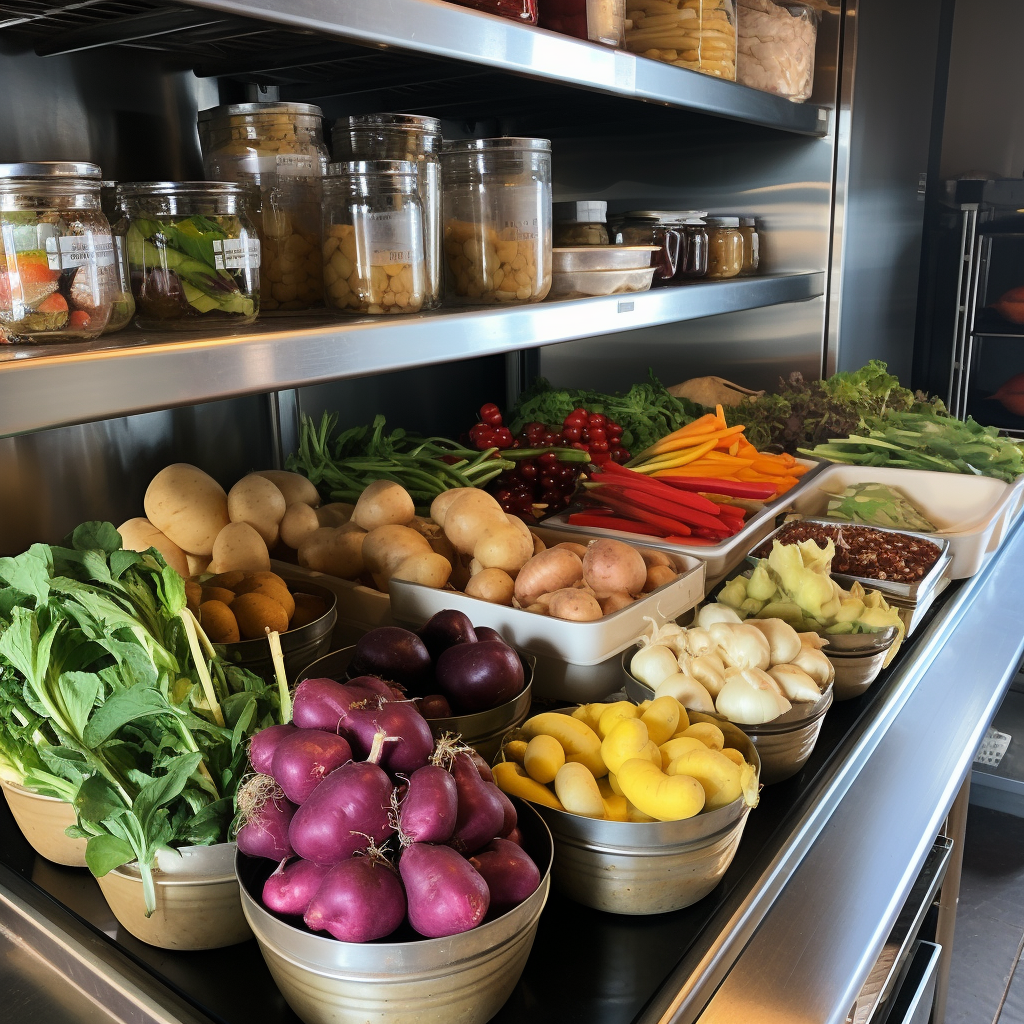Restaurant sustainability practices are rapidly revolutionizing the culinary world, prompting the pertinent question of how can restaurants be more sustainable.
This shift towards sustainable operations is not only a response to growing environmental concerns but also a strategic move that caters to the increasingly eco-conscious customer base.
In this guide, we'll explore notable trends impacting the industry, shedding light on innovative practices and their potential to transform the way eateries operate and shape our dining experiences.
How restaurant sustainability trends are affecting business and consumers
First things first — why is sustainability so important to the restaurant industry?
The answer is straightforward: environmental and social responsibility. By implementing strategies to reduce food waste, conserve energy, and source ingredients locally, restaurants can not only lower their operational costs but also strengthen their brand image as responsible and eco-conscious establishments.
According to a 2021 Global Sustainability Study conducted by Simon-Kucher & Partners, 34% of consumers are willing to pay more for sustainable products, highlighting the growing awareness and demand for eco-friendly options.
This means that restaurants that prioritize sustainability can potentially attract more customers and increase their profits.
As for consumers, the rise of sustainability in restaurants aligns with the growing desire to make ethical and environmentally conscious choices. This has led to an increase in demand for sustainable and locally sourced ingredients, as well as eco-friendly packaging options.
With technology playing a key role in modern dining experiences, digital platforms are emerging that connect eco-conscious customers with sustainable restaurants. These platforms are not only providing consumers with more options, but also helping restaurants reach a wider audience and promote their sustainable practices.
10 restaurant sustainability practices
Now that we've covered why sustainability matters, let's go over some of the most notable sustainability practices in restaurants that are worth considering:
1. Spotlight on energy efficiency
Energy efficiency is considered a cornerstone of sustainability, and restaurants across the globe are increasingly focusing on ways to reduce energy consumption. By doing so, they not only contribute to environmental preservation but also significantly decrease their operational costs.
Among the most effective sustainability examples in this regard is investing in modern restaurant appliances that consume less energy. This includes refrigerators, space heaters, and ovens — practically anything that runs on electricity. Switching to energy-efficient alternatives can result in significant savings and help restaurants reduce their carbon footprint.
In addition, transitioning to LED lighting can reduce energy consumption by up to 75%. Moreover, installing motion sensors in restrooms and other low traffic areas can ensure that lights are only switched on when needed.
These small changes can make a big difference in energy conservation for restaurants. To learn more, we recommend checking out our complete guide on how to select the right restaurant lighting.
If you're ready to make the switch, FES Lighting is here to help!
We offer a wide range of energy-efficient LED lighting options specifically designed for commercial restaurant lighting and other businesses. From overhead lights to task lighting, we have you covered.
2. Educate customers on sustainable dining
Educating customers about the importance of sustainable dining is another effective approach that numerous restaurants are adopting. By promoting transparency and sharing information about their eco-friendly practices, restaurants can engage customers in their sustainability journey.
This can be done through various mediums, such as:
- Restaurant menus
- Table tent cards
- Digital platforms like websites and social media
For instance, a restaurant could highlight the local farms from which they source their ingredients, or the renewable energy sources they use. This not only fosters a stronger connection between customers and their food but also enhances the restaurant's reputation as a sustainable business.
Moreover, restaurants can encourage sustainable dining behaviors among customers. For example, offering incentives for customers who bring their own reusable containers for takeout, or introducing a rewards program for customers who choose plant-based options, can significantly promote sustainability.
3. Water-saving measures
Significant volumes of water are used in daily restaurant operations, from cooking and cleaning to restroom facilities. By implementing water-saving measures, restaurants can decrease their water usage, contribute to environmental conservation, and reduce their utility bills.
A common water-saving strategy is installing low-flow faucets and toilets in restrooms. These fixtures are designed to use less water per flush or per minute of use, substantially reducing a restaurant's overall water consumption.
In the kitchen, investing in water-efficient appliances, such as ENERGY STAR certified dishwashers, can lead to significant water savings.
Additionally, restaurants can implement policies to save water, such as only running the dishwasher when it's fully loaded and fixing leaks promptly.
4. Farm-to-table and locally sourced ingredients
The farm-to-table trend has become increasingly popular in the restaurant industry, promoting the use of locally sourced, fresh ingredients.
Local sourcing doesn't only ensure that the food served is fresher, retaining more of its nutrients, but it also supports the local economy and reduces the restaurant's carbon footprint due to decreased transportation needs.
Restaurants can form partnerships with local farms and food producers, ensuring a fresh, reliable supply of high-quality ingredients. This also enables restaurants to more easily trace the origins of their produce, reassuring customers about the quality and safety of their food.
Highlighting such farm-to-table practices in the menu can also serve as a unique selling point, attracting customers who value fresh, organic, and locally sourced food. It allows diners to feel a deeper connection to their food, knowing it is sourced responsibly and supports their local community.
The growth of this trend is largely driven by consumer demand for transparency in food sourcing and a growing interest in supporting local businesses.
Restaurants that adopt a farm-to-table approach can position themselves as responsible, sustainable establishments, which can significantly enhance their brand image and appeal to a broader consumer base.

5. Zero-waste initiatives
The goal here is to reduce, reuse, and recycle, aiming to send as little waste as possible to landfills. Restaurants implementing these strategies focus on reducing food waste, recycling wherever possible, and even composting organic waste.
Efforts to minimize food waste can start with efficient menu planning and inventory management, ensuring that food purchases align with customer demand. Leftovers can be donated to local food banks or shelters, and food scraps can turn into compost for local farms or gardens.
In terms of recycling, restaurants can opt for recyclable or biodegradable takeaway containers, cups, and cutlery, and make sure recycling bins are readily available for customers and staff.
Some restaurants are even moving towards a closed-loop system, where waste is treated as a resource. For example, used cooking oil can be converted into biofuel, and waste water can be treated and reused.
6. Sustainable and eco-friendly packaging
Sustainable and eco-friendly packaging is an effective way for restaurants to further their environmental commitment. This involves using packaging materials that are recyclable, biodegradable, or made from renewable resources.
For instance, materials such as bagasse, a byproduct of sugarcane processing, can be used to make compostable food containers. Other options include containers made from PLA (polylactic acid), a plant-based plastic, or recycled PET (polyethylene terephthalate).
Additionally, restaurants can opt for reusable packaging systems, where customers return the packaging for cleaning and reuse. This not only reduces waste but can also lead to cost savings in the long run.
Promoting eco-friendly packaging practices to customers can also inspire them to adopt sustainable habits. For example, offering a discount to customers who bring their own reusable containers or cups can be a strong incentive.
Additional reading: restaurant lighting design
7. Go paperless
Going paperless not only saves trees but also reduces clutter and streamlines operations. Many establishments have transitioned from traditional paper methods to digital solutions for their various needs.
Menu presentations have evolved from physical paper copies to digital menus showcased on tablets or QR codes that customers can scan with their smartphones. This also enables easy and immediate updates to the menu, saving both time and resources.
Similarly, the use of digital invoicing and receipts reduces paper waste and makes tracking and accounting more efficient. Restaurants can also send e-receipts to customers via email or text messages, offering a more convenient way for customers to keep track of their expenses.
Furthermore, transitioning to electronic record-keeping for inventory, payroll, and other administrative tasks not only reduces paper usage but also simplifies data management, improves accuracy, and enables seamless information retrieval.
Adopting digital solutions positions restaurants as modern, innovative, and conscious of their environmental impact, attributes that are increasingly important to today's consumers.
8. Promote healthy food choices
Restaurants can cater to a growing demographic of health-conscious consumers by offering nutritious menu options made from whole foods.
This can involve providing more vegetarian and vegan choices, incorporating whole grains, and reducing the reliance on processed foods and added sugars. By doing so, restaurants can contribute to a healthier society while appealing to the evolving preferences of customers.
Moreover, health-oriented menu options often involve ingredients that are less resource-intensive to produce, further contributing to the restaurant's sustainability efforts.
For instance, plant-based ingredients generally require less water and land to grow than animal-based foods. Therefore, promoting healthy food aligns with both environmental sustainability and consumer well-being, making it a win-win strategy.
It's essential for restaurants to highlight these healthier options on their menus and educate customers about the benefits of these choices. By doing so, they can inspire patrons to make food choices that are good for them and good for the planet.
This not only contributes to a positive brand image but also promotes a more sustainable food culture.
9. Go with the seasons
By choosing ingredients that are in season, restaurants can support local agriculture and reduce the carbon footprint associated with transporting food from distant locations. Seasonal produce also tends to be fresher and more flavorful, enhancing the overall dining experience.
For example, serving a strawberry dessert in the middle of winter means that the strawberries have likely been shipped from a warmer climate, adding to the carbon emissions associated with the dish. On the other hand, opting for an apple dessert in the winter, when apples are in season in many parts of the world, is a more sustainable choice.
Menus can be designed to embrace the change of seasons, using the diverse range of produce available throughout the year. This not only adds variety to the menu but also allows chefs to showcase their creativity.
10. No greenwashing policy
Greenwashing refers to the practice of making unsubstantiated or misleading claims about the environmental benefits of a product, service, or company. This not only misleads consumers, but it also imposes a threat to the credibility of actual sustainable practices.
Restaurants committed to eco-friendly initiatives must ensure that their claims align with their actions.
Transparency is key — customers should be provided with clear, accurate information about the restaurant's sustainability efforts.
This could involve sharing details about the sourcing of ingredients, waste management practices, and any other relevant aspects of their operation.
Additionally, third-party certifications can be an effective way to validate a restaurant's green claims. Certifications from recognized environmental organizations can provide an objective assessment of a restaurant's sustainability efforts and give customers confidence in their claims.
Key takeaways on sustainability in restaurants
Sustainable practices in restaurants are not just a trend; they represent a fundamental shift in how the industry operates, resonating with the evolving consumer consciousness. These practices, ranging from reducing waste and energy consumption to sourcing locally and promoting healthy menu options, embody a holistic approach to sustainability.
The adoption of sustainable practices in restaurants signifies a commitment to environmental stewardship, social responsibility, and future-proofing the business. By embracing such initiatives, restaurants can contribute to a more sustainable food system, enhance their reputation among customers, and potentially even reduce operational costs.
The journey towards sustainability in the food service industry is a continuous one, with opportunities for innovation and improvement at every turn. By staying informed, adapting to changing consumer demands, and remaining committed to honest and transparent practices, restaurants can make meaningful contributions towards a more sustainable future.
Consider taking a step towards your restaurant's sustainability by upgrading to LED lighting systems - get in touch with us today!




%20(1).png?width=1080&height=1080&name=FES-Ebook-1%20(1)%20(1).png)